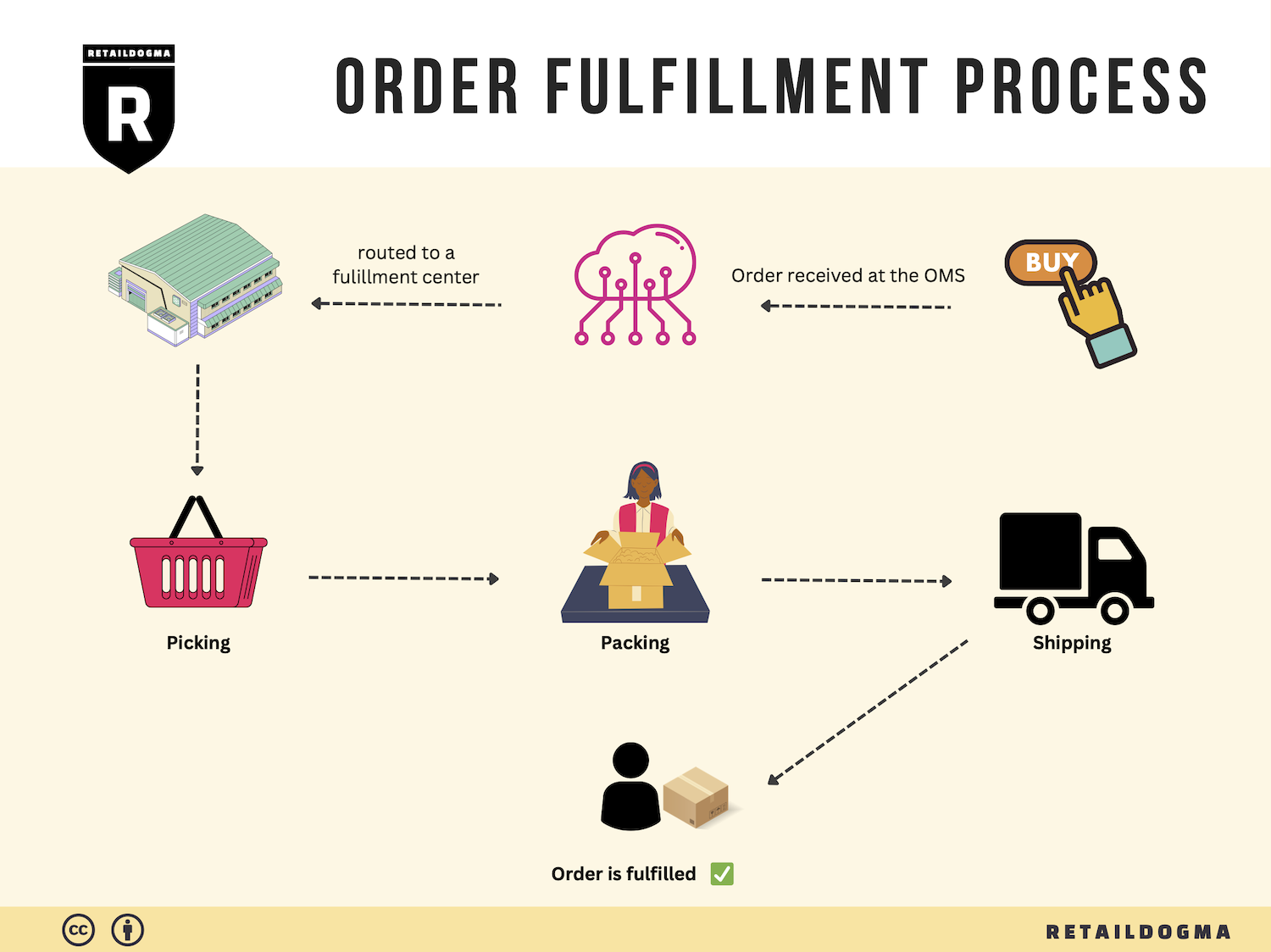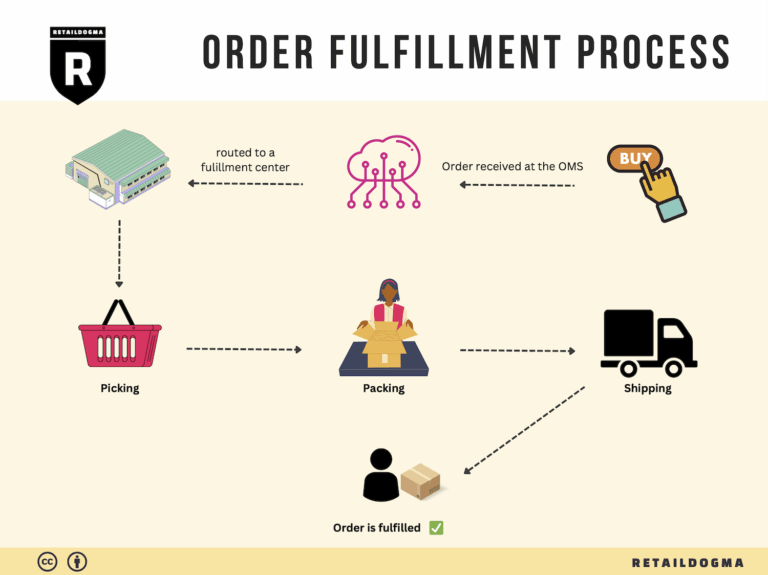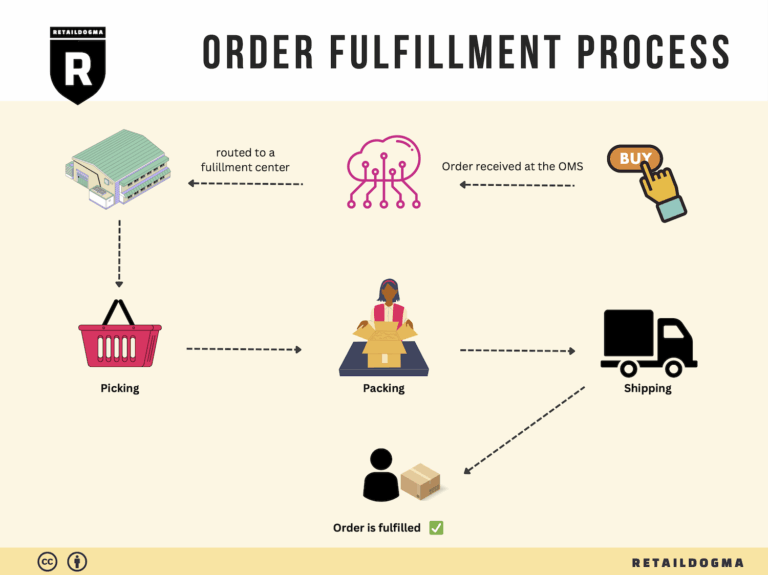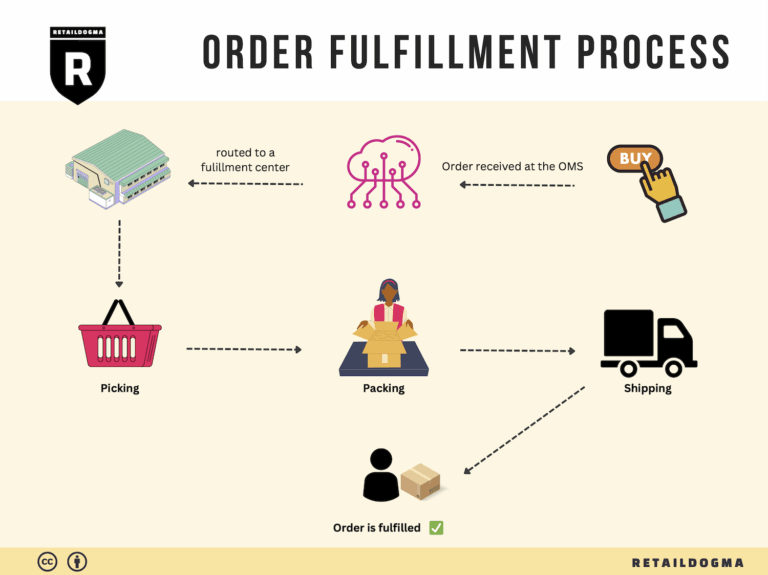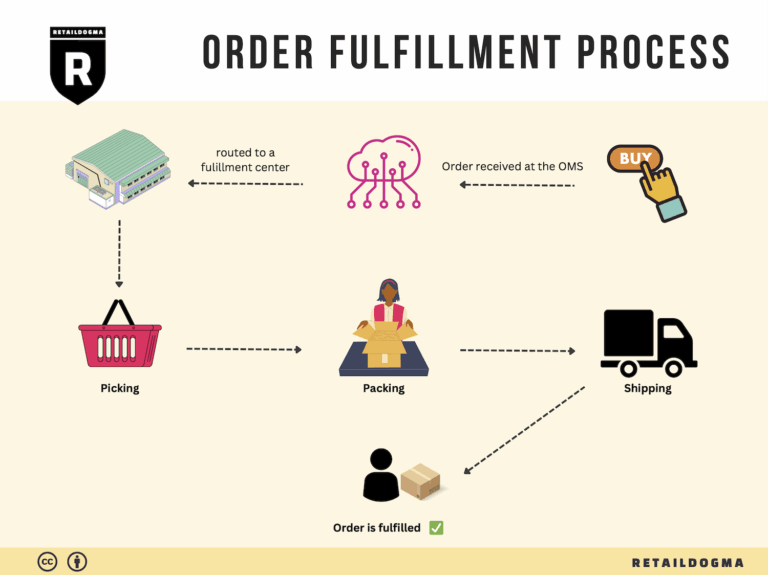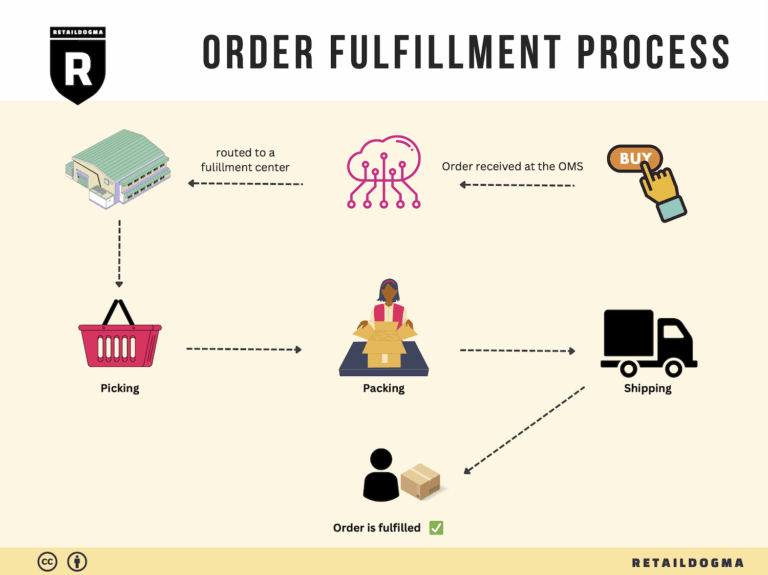What Is A Fulfillment Center? A Complete Guide (2025)
What is E-commerce Fulfillment? An Introduction for Growing Businesses
Understanding the Challenges of E-commerce Fulfillment
As an e-commerce business owner, you may find yourself grappling with a common pain point: the overwhelming task of packing and shipping orders. The excitement of growing your sales can quickly turn into stress as you navigate the complexities of logistics, ensuring timely deliveries while maintaining customer satisfaction. This is where e-commerce fulfillment comes into play, serving as a vital component in your business operations.
Fulfillment is simply the process of getting a product into the hands of your customer. It encompasses everything from receiving inventory and storing products to picking, packing, and shipping orders. For growing businesses, mastering this process is crucial, not only for efficiency but also for scaling operations without sacrificing quality.
What This Guide Will Cover
In this comprehensive guide, we will delve into various models of e-commerce fulfillment that can help you streamline your operations. You’ll learn about:
- Third-Party Logistics (3PL): An overview of how outsourcing your fulfillment needs to a third-party provider can help you focus on your core business activities while leveraging their expertise.
- Fulfillment by Amazon (FBA): Explore how utilizing Amazon’s robust fulfillment network can enhance your reach and simplify your shipping processes, especially if you’re already selling on their platform.
We will also discuss the core services you should expect from any fulfillment partner, including inventory management, order processing, and customer support, ensuring you choose a provider that aligns with your business goals.
Making Informed Decisions
Choosing the right fulfillment partner can be a daunting task, and this guide will provide you with the key factors to consider, such as location, technology integration, and scalability. We will outline effective strategies for evaluating potential partners based on their services, performance metrics, and pricing structures.
Finally, understanding the costs associated with fulfillment is essential for maintaining your profit margins. This guide will break down typical pricing models, helping you to anticipate expenses and make budget-conscious decisions.
Empowering Your Business
The ultimate goal of this guide is to empower you with the knowledge and tools necessary to make informed decisions about your logistics strategy. By understanding the intricacies of e-commerce fulfillment and exploring the various options available, you can position your business for sustainable growth and success. Whether you’re just starting or looking to optimize your existing processes, this guide is designed to provide you with actionable insights to enhance your fulfillment operations.
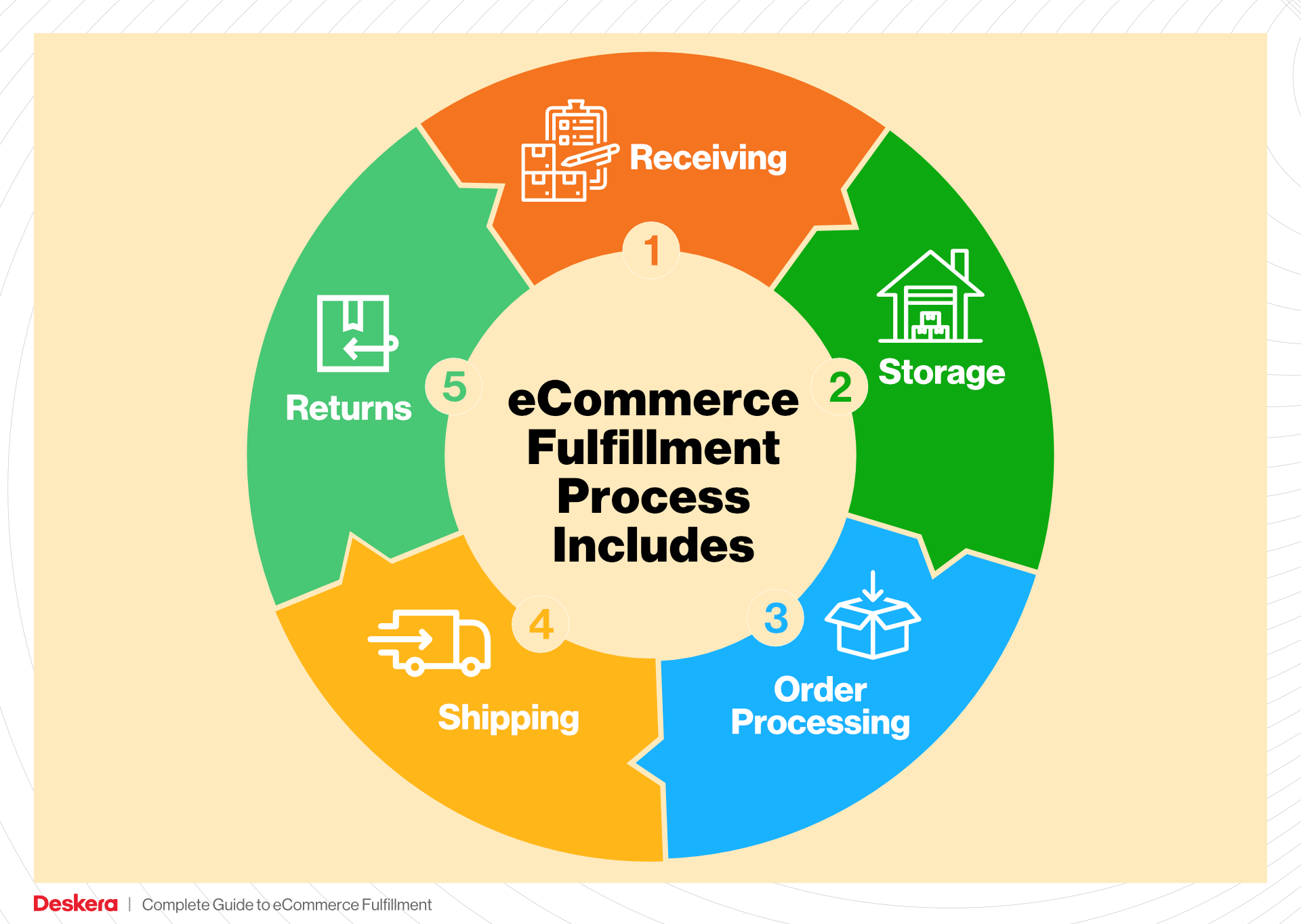
What You’ll Learn In This Guide
- What is E-commerce Fulfillment? An Introduction for Growing Businesses
- The Order Fulfillment Process: From ‘Buy’ Button to Customer’s Door
- Comparing Fulfillment Models: In-House vs. 3PL vs. Dropshipping
- A Deep Dive into Amazon FBA: Pros, Cons, and Who It’s For
- Core Services Offered by Fulfillment Centers
- How to Choose a Fulfillment Partner: A 6-Point Checklist
- Understanding Fulfillment Pricing: A Breakdown of Common Fees
- Frequently Asked Questions (FAQs) about Fulfillment
- Conclusion: Is Outsourcing Fulfillment the Right Move for Your Business?
- Important Disclaimer
The Order Fulfillment Process: From ‘Buy’ Button to Customer’s Door
1. Receiving Inventory
The order fulfillment process begins with receiving inventory, where products are delivered to the fulfillment center. This step is crucial as it sets the stage for accurate order processing. Upon arrival, items are checked against purchase orders to ensure the correct quantity and quality are received.
Key Term: SKU (Stock Keeping Unit)
Each product is assigned a unique SKU that simplifies tracking and inventory management. This identifier allows for efficient organization and retrieval of products later in the process. Establishing a reliable receiving system helps reduce discrepancies and ensures that the inventory is ready for the next phases of fulfillment.
2. Warehouse Storage
Once the inventory is received and verified, it moves to the warehouse storage phase. Here, products are organized and stored in designated locations within the fulfillment center. Proper storage is vital for maintaining inventory accuracy and ensuring fast retrieval during order picking.
Key Term: Bin Locations
Products are often stored in specific bin locations, which can be organized based on various factors such as product size, weight, or sales velocity. Efficient warehouse layout and organization reduce the time it takes to locate items, contributing to overall operational efficiency.
3. Order Picking
The next step is order picking, where warehouse workers or automated systems retrieve items from storage to fulfill customer orders. This phase is critical, as it directly impacts order accuracy and customer satisfaction. Efficient picking methods can significantly enhance the speed of order processing.
Key Term: Pick Lists
A pick list is generated for each order, detailing the items and their respective bin locations. This document helps pickers efficiently navigate the warehouse to collect the necessary products. Implementing advanced picking technologies, such as voice-picking systems or mobile devices, can further streamline this process and reduce errors.
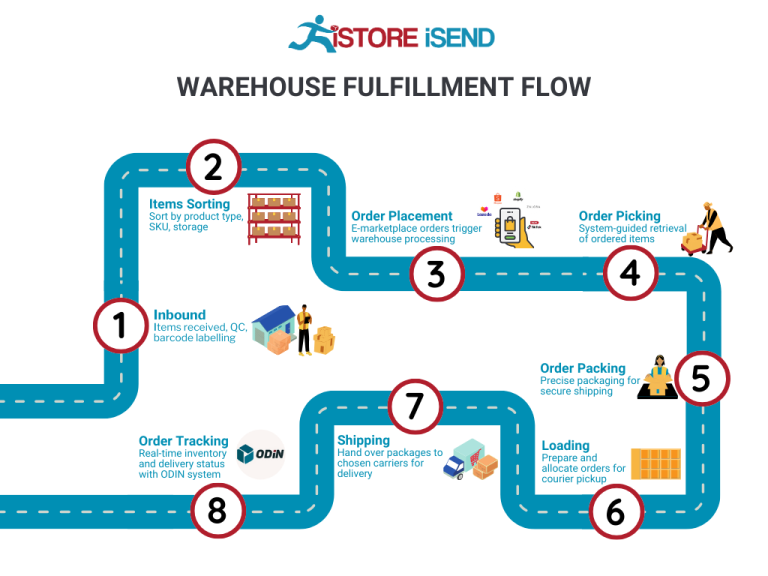
4. Order Packing
After picking, the items move to the order packing stage. Here, products are carefully packed into boxes or containers for shipping. This step is crucial for ensuring that items arrive at their destination in perfect condition and that packaging meets carrier requirements.
Key Term: Packing Slip
A packing slip accompanies each order, detailing the items included in the shipment. This document serves as a confirmation for both the customer and the fulfillment center, ensuring that the correct items are sent. Proper packing techniques, such as using appropriate cushioning materials, are essential to prevent damage during transit.
5. Shipping & Delivery
The final step in the order fulfillment process is shipping and delivery. Once packed, orders are labeled and handed over to shipping carriers for delivery to customers. This phase is critical as it influences the overall customer experience and satisfaction.
Key Term: Last-Mile Delivery
Last-mile delivery refers to the final step of the shipping process, where the package is transported from a distribution center to the customer’s doorstep. Efficient last-mile logistics are essential for meeting customer expectations, particularly in today’s market where fast delivery is increasingly demanded. Utilizing local delivery stations, like Amazon’s last-mile warehouse in Sioux Falls, can significantly enhance delivery speed and efficiency.
Conclusion
Understanding the order fulfillment process is vital for e-commerce businesses aiming to scale their operations. Each step, from receiving inventory to shipping and delivery, plays a crucial role in ensuring customer satisfaction and operational efficiency. By optimizing these processes and utilizing key terms and technologies, businesses can enhance their logistics and better meet customer expectations.
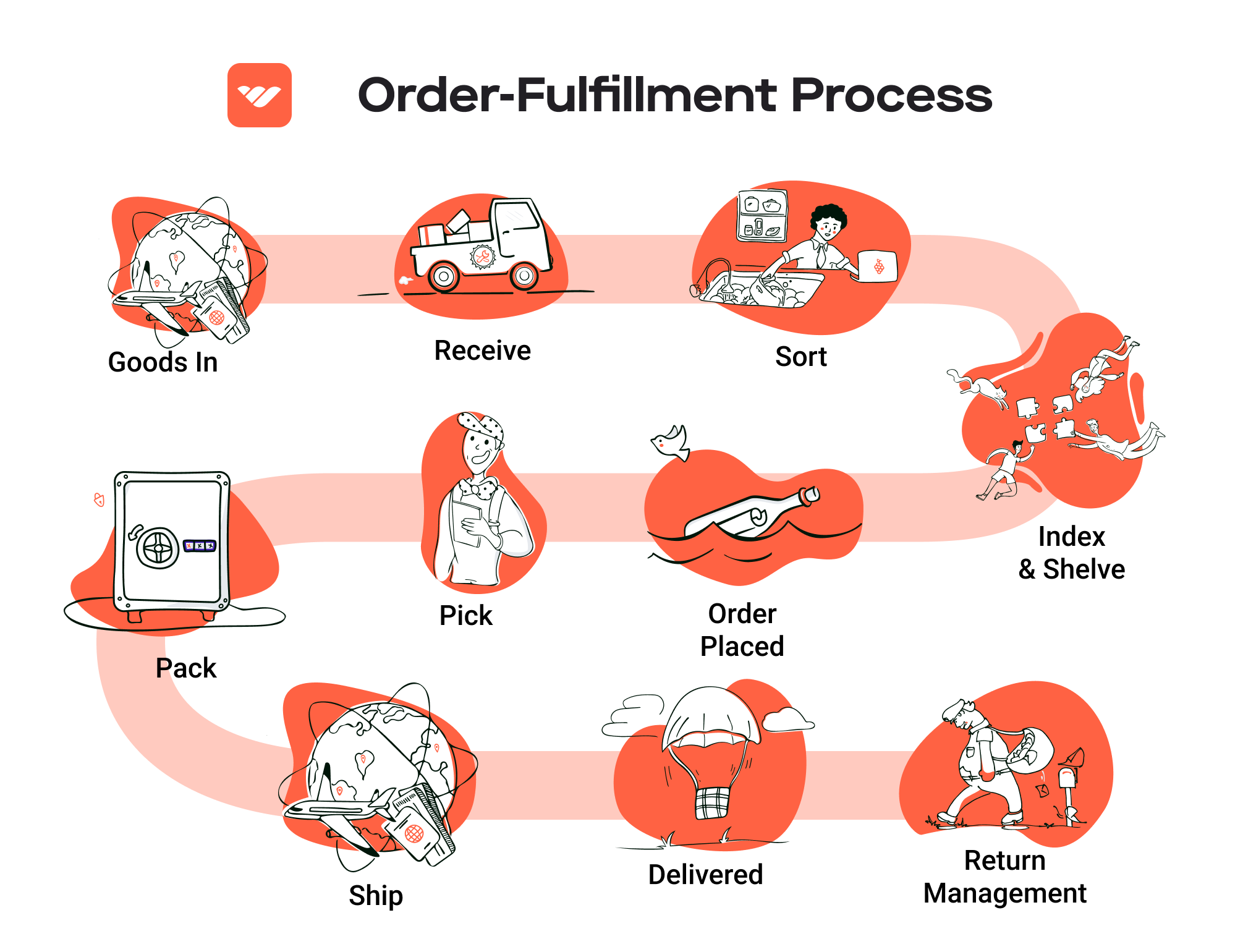
Comparing Fulfillment Models: In-House vs. 3PL vs. Dropshipping
Fulfillment Model Comparison
| Model | Who Handles Inventory | Best For (Business Stage) | Key Advantage | Key Disadvantage |
|---|---|---|---|---|
| In-House Fulfillment | Business itself | Established businesses | Full control over inventory and processes | High overhead costs and management complexity |
| Third-Party Logistics (3PL) | Third-party provider | Growing businesses | Scalable solutions and expertise | Less control over inventory and shipping |
| Dropshipping | Supplier | Startups and small businesses | Low upfront investment and risk | Lower profit margins and longer shipping times |
In-House Fulfillment
In-house fulfillment is a model where a business manages its own inventory and shipping processes. This approach is typically favored by established businesses that have the resources and infrastructure to handle logistics internally. The key advantage of in-house fulfillment is that it allows for complete control over the inventory, order processing, and customer service. Businesses can ensure quality standards are maintained, and they can implement tailored processes that suit their specific needs. However, this model comes with significant disadvantages. The overhead costs can be quite high, including expenses related to warehousing, staffing, and technology. Additionally, managing fulfillment in-house can introduce complexity, particularly as the business scales. Companies may find themselves stretched thin, especially during peak seasons or rapid growth phases, leading to potential service disruptions.
Third-Party Logistics (3PL)
Third-party logistics (3PL) is a fulfillment model where businesses outsource their logistics needs to specialized service providers. This model is particularly beneficial for growing businesses that require scalable solutions. A 3PL partner can handle warehousing, inventory management, order fulfillment, and shipping logistics, allowing businesses to focus on their core operations and customer engagement. The key advantage of utilizing a 3PL is the expertise and established networks that these providers bring, which can lead to improved efficiency and potentially lower shipping costs. However, the trade-off is that businesses relinquish some control over their inventory and shipping processes. This can lead to challenges in maintaining consistent service levels and quality assurance, particularly if the 3PL does not align closely with the business’s operational standards. As a business grows and its logistics needs evolve, it’s crucial to choose a reliable 3PL partner that can adapt to changing demands.
Dropshipping
Dropshipping is a fulfillment method where the retailer does not keep goods in stock. Instead, when a retailer sells a product, it purchases the item from a third-party supplier who then ships it directly to the customer. This model is especially popular among startups and small businesses due to its low upfront investment and minimal risk. Retailers can offer a wide range of products without the need to invest heavily in inventory, allowing for a more flexible and agile business model. However, dropshipping has its downsides. Profit margins tend to be lower compared to traditional retail models, as suppliers often charge higher wholesale prices. Additionally, shipping times can be extended since products are shipped directly from the supplier, which may affect customer satisfaction. Furthermore, since the retailer has less control over inventory and shipping, issues such as stock shortages or quality discrepancies can arise, potentially damaging the retailer’s reputation.
In summary, each fulfillment model—In-House, 3PL, and Dropshipping—has its own set of advantages and disadvantages. The right choice depends on the specific needs, resources, and growth stage of the business. Understanding these models thoroughly will help e-commerce business owners, operations managers, and entrepreneurs make informed decisions that align with their strategic goals and operational capabilities.
A Deep Dive into Amazon FBA: Pros, Cons, and Who It’s For
Understanding Fulfillment by Amazon (FBA)
Fulfillment by Amazon (FBA) is a service that allows sellers to store their products in Amazon’s fulfillment centers. Amazon takes care of storage, packaging, shipping, and customer service, enabling sellers to focus on their core business activities. By leveraging Amazon’s extensive logistics network, sellers can reach millions of customers while benefiting from Amazon’s trusted brand reputation.
How FBA Works
-
Product Listing: Sellers create product listings on Amazon and select FBA as their fulfillment method. They can either create new listings or convert existing ones to FBA.
-
Inventory Shipment: Sellers prepare their products and ship them to Amazon’s fulfillment centers. Amazon provides guidelines for packaging and labeling to ensure products are ready for storage and shipment.
-
Storage: Once products arrive at an Amazon fulfillment center, they are stored until sold. Amazon manages inventory levels and provides sellers with real-time updates on stock levels.
-
Order Fulfillment: When a customer places an order for an FBA product, Amazon handles the entire fulfillment process. This includes picking the product from the warehouse, packing it, and shipping it directly to the customer.
-
Customer Service: Amazon also manages customer service inquiries and returns for FBA products, allowing sellers to maintain a high level of customer satisfaction without additional effort.
-
Payment: After the order is shipped, sellers receive payment for their sales, minus Amazon’s fees for using the FBA service.
Pros of FBA
1. Prime Eligibility
One of the most significant advantages of FBA is the ability for sellers to offer their products to Amazon Prime members. Prime members enjoy free two-day shipping on eligible items, which can significantly increase sales. The Prime badge also enhances product visibility and trust, attracting more customers.
2. Customer Trust
Amazon is a well-established and trusted brand. By using FBA, sellers can leverage this trust, as customers often prefer products fulfilled by Amazon due to the reliability and quality of service. This can lead to higher conversion rates and repeat purchases.
3. Multi-Channel Fulfillment
FBA is not limited to Amazon alone. Sellers can use FBA to fulfill orders from other sales channels, such as their own websites or other e-commerce platforms. This multi-channel fulfillment capability allows businesses to streamline their logistics and offer consistent service across platforms.
4. Reduced Operational Burden
By outsourcing storage, packing, and shipping to Amazon, sellers can focus on other critical aspects of their business, such as product development and marketing. This can be particularly beneficial for small businesses and entrepreneurs who may lack the resources to manage logistics efficiently.
5. Inventory Management Tools
Amazon provides sellers with various tools and reports to help manage their inventory effectively. These insights can assist in optimizing stock levels, forecasting demand, and reducing the risk of stockouts or overstocking.
Cons of FBA
1. High Fees
While FBA offers numerous benefits, it also comes with costs. Sellers must pay for storage fees based on the volume of inventory stored and fulfillment fees for each order processed. These costs can add up quickly, especially for businesses with low margins or high turnover rates.
2. Strict Inventory Rules
Amazon has stringent rules regarding inventory management. Sellers must adhere to guidelines for labeling, packaging, and shipping products. Failure to comply can result in additional fees or penalties, which can be burdensome for sellers.
3. Commingling Risks
When products are commingled with those of other sellers, there is a risk that customers may receive items that do not match the seller’s quality standards. This can lead to negative reviews and damage to the seller’s reputation. Sellers must carefully consider whether to opt for commingled inventory or individual labeling.
4. Limited Control Over Fulfillment
Once products are in Amazon’s hands, sellers have limited control over the fulfillment process. Issues such as shipping delays or inventory mismanagement can impact customer satisfaction and sales performance. Sellers must rely on Amazon to uphold their service standards.
5. Inventory Storage Limitations
Amazon may impose storage limits based on a seller’s sales performance and inventory turnover rate. If a seller exceeds these limits, they may face additional fees or restrictions, which can hinder their ability to scale effectively.
Who is FBA Best For?
FBA is particularly well-suited for:
-
Small to Medium-Sized E-commerce Businesses: Those looking to streamline their logistics and reduce operational burdens can benefit significantly from FBA. It allows them to compete with larger brands without the need for extensive infrastructure.
-
Sellers with High Sales Volume: Businesses with a steady sales volume can leverage FBA to maximize their operational efficiency while minimizing fulfillment costs on a per-unit basis.
-
Brands Looking to Build Trust: Companies that want to enhance their credibility and customer trust can benefit from the Amazon Prime badge and the overall reliability of Amazon’s fulfillment services.
-
Multi-Channel Sellers: Businesses that sell on multiple platforms can use FBA to manage their inventory and fulfillment processes more effectively, ensuring consistency across all sales channels.
In summary, Fulfillment by Amazon offers a robust solution for sellers aiming to scale their e-commerce operations. While there are challenges associated with fees and control over fulfillment, the benefits of increased visibility, customer trust, and operational efficiency often outweigh the drawbacks, making it a valuable option for many e-commerce businesses.
Core Services Offered by Fulfillment Centers
Inventory Management & Warehousing
Inventory management and warehousing are foundational services offered by fulfillment centers that enable e-commerce businesses to efficiently store and oversee their stock. Fulfillment centers utilize advanced inventory management systems to track the quantity, location, and status of products in real-time. This service ensures that businesses maintain optimal stock levels, preventing both overstock and stockouts.
The benefits of effective inventory management are manifold. Firstly, it allows for better forecasting and planning, enabling businesses to align their inventory with consumer demand. This minimizes carrying costs and enhances cash flow. Furthermore, a well-organized warehouse can significantly speed up the order fulfillment process, leading to quicker shipping times. For e-commerce businesses, particularly those looking to scale, maintaining an efficient inventory system is critical to meet customer expectations and enhance the overall shopping experience.
Pick and Pack Services
Pick and pack services are essential for the operational efficiency of fulfillment centers. This process involves selecting items from the warehouse (picking) and preparing them for shipment (packing). Fulfillment centers employ various technologies, including automated systems and skilled workers, to ensure that orders are accurately picked and efficiently packed for delivery.
The primary advantage of pick and pack services is the reduction of errors and the increase in speed. By streamlining the picking process, fulfillment centers can significantly decrease the time taken from order placement to shipment. For e-commerce businesses, this translates into faster delivery times, which is a critical factor for customer satisfaction. Additionally, effective packing minimizes the risk of damage during transit, ensuring that products arrive in pristine condition. This service not only enhances operational efficiency but also fosters customer loyalty through reliable service.
Kitting and Assembly
Kitting and assembly services involve bundling products together into a single package or creating assembled products from individual components. This service is particularly beneficial for businesses that sell products requiring multiple items to be combined, such as gift sets, promotional kits, or complex machinery. Fulfillment centers can manage the entire kitting process, from sourcing the components to assembling them for shipment.
The benefits of kitting and assembly services extend beyond mere convenience. By outsourcing this process, e-commerce businesses can save valuable time and resources, allowing them to focus on core activities like marketing and customer engagement. Additionally, kitting can enhance the perceived value of products by offering customers bundled items at a competitive price, which can lead to increased sales. This service also simplifies inventory management, as businesses can track bundled products as single SKUs, improving overall inventory accuracy.
Returns Management (Reverse Logistics)
Returns management, or reverse logistics, is a critical service offered by fulfillment centers that helps e-commerce businesses efficiently handle product returns. This process includes receiving returned items, inspecting their condition, processing refunds or exchanges, and restocking items as necessary. Effective returns management is crucial, particularly in an era where consumer expectations regarding returns are higher than ever.
The primary benefit of a robust returns management system is the enhancement of customer trust and satisfaction. A seamless return process can significantly improve a customer’s overall shopping experience, encouraging repeat purchases and fostering brand loyalty. Furthermore, fulfillment centers can analyze return data to identify trends and issues with specific products, allowing businesses to make informed decisions about inventory, product quality, and customer preferences. By outsourcing returns management, e-commerce businesses can optimize their operations, reduce overhead costs associated with returns, and focus on their growth strategies.
Conclusion
In summary, the core services offered by fulfillment centers—inventory management and warehousing, pick and pack services, kitting and assembly, and returns management—are indispensable for e-commerce businesses looking to scale. Each service plays a vital role in enhancing operational efficiency, improving customer satisfaction, and ultimately driving sales growth. By leveraging these services, businesses can streamline their logistics processes, reduce costs, and focus on what they do best: delivering exceptional products and experiences to their customers.
How to Choose a Fulfillment Partner: A 6-Point Checklist
Location & Warehouse Network
Importance:
The location of a fulfillment partner’s warehouses is critical for efficient logistics and timely delivery. A strategically placed warehouse network can significantly reduce shipping times and costs, particularly for e-commerce businesses that rely on quick delivery to remain competitive.
Questions to Ask:
– Where are your warehouses located, and how does this align with my target markets?
– Can you provide details on your last-mile delivery capabilities in specific regions, such as Sioux Falls?
– What is the average shipping time from your warehouses to my customers?
Technology & Integrations
Importance:
In today’s digital landscape, a fulfillment partner’s technology stack can make or break operational efficiency. Robust systems for inventory management, order processing, and tracking are essential for maintaining a seamless flow of information and ensuring customer satisfaction.
Questions to Ask:
– What technology platforms do you use for order management and inventory tracking?
– How do you handle data integration with existing e-commerce platforms (e.g., Shopify, Amazon)?
– Can you provide real-time visibility into inventory levels and order statuses?
Specializations (e.g., Cold Storage, Oversized Items)
Importance:
Different businesses have unique needs based on their product types. A partner that specializes in handling specific categories, such as cold storage for perishables or oversized items, can provide tailored solutions that enhance service quality and reduce risk.
Questions to Ask:
– What specializations do you have that align with my product offerings?
– Do you have the facilities and expertise to handle unique storage requirements (e.g., climate control, hazardous materials)?
– Can you accommodate seasonal fluctuations in inventory levels for specialized items?
Scalability & Capacity
Importance:
As your business grows, your fulfillment needs will evolve. A partner’s ability to scale operations and adapt to increased demand is vital for supporting long-term growth without compromising service quality.
Questions to Ask:
– What is your current capacity, and how do you plan to scale operations as my business grows?
– Are there any restrictions on the volume of products you can handle during peak seasons?
– How do you manage inventory overflow, and what contingency plans are in place for unexpected demand spikes?
Pricing and Contracts
Importance:
Understanding the pricing structure and contract terms is essential for budgeting and forecasting. Transparent pricing models help avoid hidden fees and ensure that the partnership remains financially viable as your business evolves.
Questions to Ask:
– What are your pricing models (e.g., per order, per item, monthly fees), and what factors influence these costs?
– Are there any additional fees for services such as storage, picking, packing, or returns?
– What are the contract terms, and is there flexibility for renegotiation as my business needs change?
Customer Support & Reviews
Importance:
A responsive and knowledgeable customer support team can significantly impact your overall experience with a fulfillment partner. Additionally, customer reviews and testimonials provide insight into the reliability and quality of service.
Questions to Ask:
– What support channels do you offer (e.g., phone, email, live chat), and what are your response times?
– Can you provide references or case studies from other businesses similar to mine?
– How do you handle issues related to order accuracy, delays, or damage, and what is your process for resolving these problems?
Conclusion
Choosing the right fulfillment partner is a critical decision that can influence your e-commerce business’s operational efficiency and customer satisfaction. By following this checklist and asking the right questions, you can ensure that you select a partner that aligns with your business goals and can support your growth in the competitive e-commerce landscape. Whether you’re considering a partner near your market, such as the Amazon fulfillment center in Sioux Falls, or exploring other options, thorough due diligence will help you make an informed decision that propels your business forward.
Understanding Fulfillment Pricing: A Breakdown of Common Fees
Initial Setup Fees
When partnering with a fulfillment center, one of the first costs you might encounter is the initial setup fee. This fee typically covers the onboarding process, which includes integrating your e-commerce platform with the fulfillment provider’s systems, setting up inventory management, and configuring your shipping parameters. The setup fee can vary significantly based on the complexity of your operations and the fulfillment center’s technology.
Calculation: Initial setup fees can range from a few hundred to several thousand dollars, depending on the provider and the specific services you require. Some fulfillment centers may offer free setup if you commit to a long-term contract, while others may charge a flat fee regardless of your order volume.
Receiving Fees
Receiving fees are charged when inventory arrives at the fulfillment center. These fees cover the labor and resources needed to unload, inspect, and store your products. The cost can vary based on the size and complexity of the items being received.
Calculation: Typically, receiving fees are calculated per pallet or per item. For example, a fulfillment center might charge $25 per pallet or $0.50 per item received. If your inventory comes in multiple formats (boxes, pallets, etc.), be prepared for varying costs.
Storage Fees (per pallet/bin)
Storage fees are an ongoing cost associated with keeping your inventory at the fulfillment center. These fees are charged for the space your products occupy and can vary based on the storage duration and the type of storage (standard vs. climate-controlled).
Calculation: Storage fees are often calculated on a monthly basis, either per pallet or per cubic foot. For instance, a fulfillment center might charge $15 per pallet per month or $0.10 per cubic foot. It’s important to monitor your inventory levels to avoid overpaying for storage, especially if you have slow-moving items.
Pick & Pack Fees (per item/order)
Pick and pack fees are charged for the labor involved in picking items from inventory and packing them for shipment. These fees can vary based on the number of items in each order and the complexity of the packing process (e.g., special packaging requirements).
Calculation: Pick and pack fees are typically assessed per item or per order. For example, a fulfillment center might charge $1.00 per item picked and $0.50 per order packed. If your business experiences seasonal fluctuations, be aware that these fees can add up quickly during peak seasons when order volumes increase.
Shipping Fees
Shipping fees are one of the most critical components of fulfillment pricing, as they directly impact your overall cost structure and customer satisfaction. These fees cover the cost of transporting packages from the fulfillment center to the end customer and can vary significantly based on shipping methods, distances, and package dimensions.
Calculation: Shipping fees are usually calculated based on weight, dimensions, destination, and the speed of delivery. For instance, a fulfillment center may charge a flat rate for standard shipping (e.g., $5 for orders under 5 lbs) or use a tiered pricing model based on weight brackets (e.g., $5 for 0-5 lbs, $10 for 6-10 lbs). It’s essential to negotiate shipping rates with your fulfillment partner, especially if you plan to scale your operations.
Tips for Getting an Accurate Quote
-
Provide Detailed Information: When requesting quotes, be specific about your product types, average order sizes, and expected order volumes. This information helps fulfillment centers provide tailored pricing.
-
Understand Your Needs: Assess your business model and shipping requirements. Do you require special handling for fragile items? Are your products seasonal? Understanding your needs will help you compare pricing more effectively.
-
Request Breakdown of Fees: Ask for a detailed breakdown of all potential fees, including any variable costs based on order volume. This will allow you to see the full picture and avoid hidden fees later.
-
Negotiate: Don’t hesitate to negotiate terms and pricing with fulfillment centers. Many providers are open to adjusting fees based on volume commitments or long-term contracts.
-
Compare Multiple Providers: Finally, get quotes from several fulfillment centers to compare pricing and service offerings. This will give you leverage in negotiations and help you choose the best partner for your business.
By understanding these common fulfillment pricing models and taking proactive steps to obtain accurate quotes, you can make informed decisions that support your e-commerce growth and profitability.
Frequently Asked Questions (FAQs) about Fulfillment
1. What is the Amazon Fulfillment Center in Sioux Falls?
The Amazon Fulfillment Center in Sioux Falls is a state-of-the-art facility designed to optimize the storage, picking, packing, and shipping of products to customers in South Dakota and surrounding areas. Opened in October 2022, it features advanced robotics technology to enhance efficiency and supports next-day delivery for millions of items.
2. How does the fulfillment process work at the Sioux Falls center?
Orders are received at the fulfillment center where items are stored. When an order is placed, robotics assist workers by bringing the items to designated packing stations. Once packed, orders are shipped directly to customers or transferred to last-mile delivery stations for final delivery.
3. What is the difference between a warehouse and a fulfillment center?
A warehouse primarily focuses on storing goods, while a fulfillment center is dedicated to processing orders, including picking, packing, and shipping. Fulfillment centers are equipped with technology and infrastructure to handle the complexities of e-commerce logistics and often prioritize speed and efficiency.
4. What is a 3PL (Third-Party Logistics)?
A Third-Party Logistics (3PL) provider is a service that allows businesses to outsource their logistics and fulfillment operations. This can include warehousing, inventory management, order fulfillment, and shipping. Using a 3PL can help businesses scale without the need for significant capital investment in their own logistics infrastructure.
5. How much do fulfillment services cost?
Costs for fulfillment services can vary widely based on factors such as order volume, the complexity of the logistics process, and specific services required (e.g., storage, packing, shipping). On average, businesses can expect to pay per order, per item stored, and for shipping costs. It’s essential to obtain quotes from potential fulfillment partners to understand specific pricing structures.
6. What types of products can be fulfilled at the Sioux Falls center?
The Sioux Falls fulfillment center can handle a wide range of products, from small items like toiletries to larger items such as kitchen appliances. However, items exceeding certain dimensions may be shipped from other facilities. This variety allows businesses to utilize the center for diverse product lines.
7. What are the employment opportunities at the Amazon fulfillment center in Sioux Falls?
The fulfillment center offers numerous job opportunities, including roles for pickers, packers, warehouse associates, and delivery drivers. Positions typically start at competitive hourly rates, with additional benefits and training programs available to employees from their first day.
8. How does Amazon ensure the safety of its workers at the Sioux Falls center?
Amazon prioritizes worker safety by implementing advanced safety protocols, ergonomic training, and providing specialty safety equipment. Employees participate in regular safety training sessions and are encouraged to address any safety concerns with management, fostering a safe working environment.
9. What is the expected delivery speed for orders processed at the Sioux Falls center?
Orders processed at the Sioux Falls fulfillment center are generally eligible for next-day delivery, significantly improving the customer experience in the region. This speed is facilitated by the efficient logistics and advanced technology employed at the facility.
10. How does Amazon’s fulfillment center in Sioux Falls support local businesses?
By providing a robust fulfillment infrastructure, the Sioux Falls center enables local businesses to leverage Amazon’s logistics capabilities. This allows them to reach a wider customer base and offer faster shipping options, ultimately supporting their growth and competitiveness in the e-commerce landscape.
Conclusion: Is Outsourcing Fulfillment the Right Move for Your Business?
Evaluating the Benefits of Outsourcing Fulfillment
Outsourcing fulfillment can be a transformative decision for e-commerce businesses seeking to scale efficiently. By leveraging third-party fulfillment services, companies can save significant time and resources. This allows business owners and operations managers to focus on core activities such as product development, marketing, and customer engagement rather than getting bogged down in the complexities of logistics and warehousing.
One of the standout advantages of using a fulfillment service is scalability. As your business grows, so too does the demand for order processing and shipping. Fulfillment partners can easily adjust to fluctuations in order volume, ensuring that you can meet customer expectations without the need for substantial capital investment in infrastructure or workforce. This flexibility is especially crucial during peak seasons or promotional events when order volumes can surge unexpectedly.
Additionally, partnering with a fulfillment expert brings specialized knowledge and technology into your operations. Fulfillment centers, like the newly opened Amazon facility in Sioux Falls, employ advanced automation and efficient processes that can significantly enhance order accuracy and speed. By tapping into this expertise, you can improve your service levels and customer satisfaction without needing to manage every aspect of the logistics process.
However, it is essential to choose the right fulfillment partner to align with your business goals and operational needs. Conducting a thorough evaluation of potential partners—considering their capabilities, technology, and service levels—will be crucial to ensuring a successful collaboration.
Call to Action
As you weigh the potential benefits of outsourcing fulfillment, take a moment to audit your current shipping process. Assess whether the inefficiencies you face could be alleviated through a partnership with a fulfillment service. By doing so, you can determine if outsourcing is the right strategic move to support your business growth and enhance your customer experience.
Important Disclaimer
⚠️ Important Disclaimer
The information in this guide is for educational purposes. Fulfillment services, pricing, and platform features change frequently. Always conduct your own due diligence and consult with providers directly before making business decisions.
